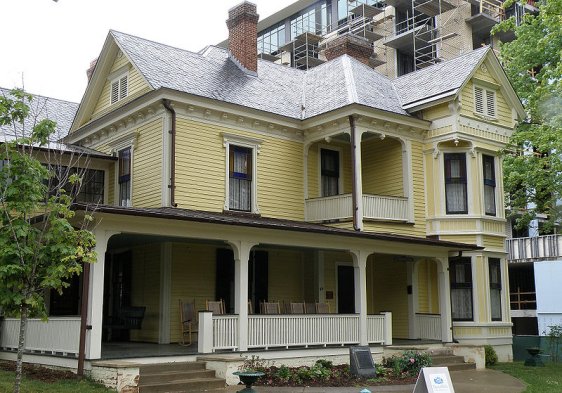 Asheville is the county seat of Buncombe County in the western part of North Carolina. It covers 41.3 sq mi (107 sq km) and has a population of 84,000 people (2011 estimate). The city is located in the Blue Ridge Mountains, at the confluence of the Swannanoa River and the French Broad River, about 2,134 ft (650 m) above sea level.
Asheville is the county seat of Buncombe County in the western part of North Carolina. It covers 41.3 sq mi (107 sq km) and has a population of 84,000 people (2011 estimate). The city is located in the Blue Ridge Mountains, at the confluence of the Swannanoa River and the French Broad River, about 2,134 ft (650 m) above sea level. Thomas Wolfe House, Asheville, North Carolina
Thomas Wolfe House, Asheville, North CarolinaSource: https://commons.wikimedia.org/wiki/File:Thomas_Wolfe%27s_Home.jpg
Author: Jim Bowen

Asheville experiences a humid subtropical climate. Due to its high altitude, it is slightly colder than other places in southeastern United States. July is the hottest month, with average high temperature of 84.3°F (29.06°C) while January is the coldest, with average low temperature of 26.6°F (-3°C). March is the wettest month, receiving 3.89 in (98.8 mm) of precipitation.
The area around Asheville was originally inhabited by Native Americans of the Cherokee Nation. The first European to set foot in the area was Spanish explorer Hernando de Soto, who arrived in 1540.
The town of Asheville was founded in 1784 when Colonel Samuel Davidson settled there with his family. Shortly thereafter, Colonel Davidson was killed by a band of Cherokee hunters, causing his twin brother Major William Davidson and brother-in-law Colonel Daniel Smith to avenge his murder. The family eventually returned to the area and resettle it.
The village was originally called Morristown, but renamed Asheville in honor of North Carolina Governor Samuel Ashe. The town received a railway line in 1880, connecting it with Salisbury. This provided an albeit moderate impetus for the town to grow, leading to factories being set up for manufacturing textile, wood, mica products and foodstuff.
Visiting Asheville
Asheville is connected by Interstate 40 and 26 to the rest of the country.Places of Interest in Asheville
- Basilica of St Lawrence
Minor basilica of the Roman Catholic Church built in 1905. - City Hall
One of the landmarks of Asheville, built in the Art Deco style. - First Presbyterian Church
Historic church building erected in 1884 in the Gothic Revival style. - Montford Area Historic District
A residential neighborhood dating to the late 19th century with a number of Victorian style buildings.
 Latest updates on Penang Travel Tips
Latest updates on Penang Travel Tips
About this website

Dear visitor, thank you so much for reading this page. My name is Timothy Tye and my hobby is to find out about places, write about them and share the information with you on this website. I have been writing this site since 5 January 2003. Originally (from 2003 until 2009, the site was called AsiaExplorers. I changed the name to Penang Travel Tips in 2009, even though I describe more than just Penang but everywhere I go (I often need to tell people that "Penang Travel Tips" is not just information about Penang, but information written in Penang), especially places in Malaysia and Singapore, and in all the years since 2003, I have described over 20,000 places.
While I try my best to provide you information as accurate as I can get it to be, I do apologize for any errors and for outdated information which I am unaware. Nevertheless, I hope that what I have described here will be useful to you.
To get to know me better, do follow me on Facebook!
Copyright © 2003-2025 Timothy Tye. All Rights Reserved.

 Go Back
Go Back